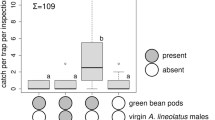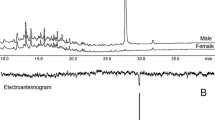Abstract
Chinavia and Nezara spp. stink bugs (Heteroptera: Pentatomidae) include over100 species, with highest diversity in Afrotropical and Neotropical regions. Species thus far studied in these genera utilize trans-(Z)-(4 S)-bisabolene epoxide (BE) and cis-(Z)-(4 S)-BE as major sex pheromone components, with species specificity ensured by different ratios of the two compounds. Gas chromatography (GC) and coupled GC-mass spectrometry (GC-MS) analyses of a volatiles from C. ubica males revealed the presence of two BE isomers in approximately a 90:10 ratio, which were shown by microprobe 1 H NMR to be cis-(Z)-BE and trans-(Z)-BE isomers, respectively. Analyses of volatiles from C. impicticornis males suggested the presence of a single isomer, trans-(Z)-BE, in high purity (>90 %). The absolute configurations of the isomers produced by C. ubica and C. impicticornis were determined using chiral GC analysis (β-DEX column). Oxidative microchemistry of synthetic standards of cis-(Z)-(4 S)-BE and trans-(Z)-(4R)-BE, and volatiles from male of C. ubica, revealed the absolute stereochemistry of the cis-(Z)-BE to be (1R,2 S,4 S) [cis-(Z)-(4 S) for short]. Similarly, analyses of trans-(Z)-(4 S)-BE and cis-(Z)-(4R)-BE standards, and volatiles from males of C. ubica and C. impicticornis, revealed the absolute stereochemistry of the trans-(Z)-BE to be (1 S,2R,4 S) [trans-(Z)-(4 S) for short]. Olfactometer bioassays with synthetic BEs confirmed attraction of female C. ubica and C. impicticornis to conspecific synthetic pheromone, but not to heterospecific synthetic pheromone. Chinavia impicticornis appeared not to discriminate behaviorally between the conspecific pheromone and its enantiomer. Coupled GC-electroantennography with antennae from females suggested that C. ubica and C. impicticornis possess olfactory receptors for both cis-(Z)-(4 S)-BE and trans-(Z)-(4 S)-BE. The results in this study confirm that C. ubica and C. impicticornis, as for other Chinavia and Nezara spp., utilize cis-(Z)-(4 S)-BE and trans-(Z)-(4 S)-BE as sex pheromone components, with different ratios guaranteeing species specificity. Furthermore, the results suggest that the absolute stereochemistry of BEs may be less important for conspecific recognition than the relative stereochemistry between the epoxide group and the alkyl substituent on the bisabolene ring.








Similar content being viewed by others
References
Aldrich, J. R., Lusby, W. R., Marron, B. E., Nicolaou, K. C., Hoffmann, M. P., and Wilson, L. T. 1989. Pheromone blends of green stink bugs and possible parasitoid selection. Naturwissenschaften. 76:173–175.
Aldrich, J. R., Numata, H., Borges, M., Bin, F., Waite, G. K., and Lusby, W. R. 1993. Artifacts and pheromone blends from Nezara spp. and other stink bugs (Heteroptera: Pentatomidae). Z. Naturforsch. C. 48:73–79.
Aldrich, J. R., Oliver, J. E., Lusby, W. R., Kochansky, J. P., and Lockwood, J. A. 1987. Pheromone strains of the cosmopolitan pest, Nezara viridula (Heteroptera: Pentatomidae). J. Exp. Zool. 244:171–175.
Aldrich, J. R. 1995. Chemical Communication in the true bugs and parasitoid exploitation, pp. 318–386, in R. T. Cardé and W. J. Bell (eds.), Chemical Ecology of Insects II. Chapman & Hall, New York.
Baker, R., Borges, M., Cooke, N. G., and Herbert, R. H. 1987. Identification and synthesis of (Z)-(1'S,3'R,4'S)(-)-2-(3',4'-epoxy-4'-methylcyclohexyl)-6-methylhepta-2,5-diene, the sex pheromone of the southern green stink bug, Nezara viridula (L.). Chem. Comm 6:414–416.
Borges, M. 1995. Attractant compounds of the southern green stink bug, Nezara viridula (L.) (Heteroptera: Pentatomidae). An. Soc. Entomol. Brasil 24:215–225.
Borges, M. and ALDRICH, J. R. 1994a. Attractant pheromone for Nearctic stink bug, Euschistus obscurus ( Heteroptera: Pentatomidae): insight into a Neotropical relative. J. Chem. Ecol. 20:1095–1102.
Borges, M. and ALDRICH, J. R. 1994b. Estudos de semioquímicos para o manejo de Telenominae, insetos benéficos. An. Soc. Entomol. Brasil. 23:575–577.
Borges, M., Aldrich, J. R., Oliver, J. E., Birkett, M., Chiba, M., Murata, Y., Chuman, T., Laumann, R. A., Barrigossi, J. A., Pickett, J. A., and Moraes, M. C. B. 2006. Sex attractant pheromone from the rice stalk stink bug, Tibraca limbativentris Stal (Hemiptera: Pentatomidae). J. Chem. Ecol. 32:2749–2761.
Borges, M., Jepson, P. C., and Howse, P. E. 1987. Long-range mate location and close-range courtship behaviour of the green stink bug, Nezara viridula and its mediation by sex pheromones. Entomol Exp. Appl. 44:205–212.
Borges, M., Millar, J. G., Laumann, R. A., and Moraes, M. C. B. 2007. A male-produced sex pheromone from the neotropical redbanded stink bug, Piezodorus guildinii (W.). J. Chem. Ecol. 33:1235–1248.
Borges, M., Moraes, M. C. B., Peixoto, M. F., Pires, C. S. S., Sujii, E. R., and Laumann, R. A. 2011. Monitoring the neotropical brown stink bug Euschistus heros (F.) (Hemiptera:Pentaomidae) with pheromone baited-traps in soybean fields. J. App. Entomol. 135:68–80.
Borges, M., Schmidt, F. G. V., Sujii, E. R., Medeiros, M. A., Mori, K., Zarbin, P. H. G., and Ferreira, T. B. 1998. Field responses of stink bugs to the natural and synthetic pheromone of the Neotropical brown stink bug, Euschistus heros (Heteroptera: Pentatomidae). Physiol. Entomol. 23:202–207.
Brezot, P., Malosse, C., Mori, K., and Renou, M. 1994. Bisabolene epoxides in sex pheromone in Nezara viridula (L.) (Heteroptera: Pentatomidae): role of cis isomer and relation to specificity of pheromone. J. Chem. Ecol. 20:3133–3147.
Chen, X., Gottlieb, L., and MILLAR, J. G. 2000. Highly stereoselective syntheses of the sex pheromone components of the southern grenn stink bug Nezara viridula (L.) and the green stink bug Acrosternum hilare (Say). Synthesis 2:269–272.
Clarke, R. G. and Wilde, G. E. 1970. Association of the green stink bug and the yeast spot disease organism of soybeans. I. Length of retention, effect of moulting, isolation from feces and saliva. J. Econ. Entomol. 3:200–204.
Costa, M. L. M., Borges, M., Vilela, E. F., de Marco, P. J. R., and LIMA, E. R. 2000. Effect of stereoisomers of the main component of the sex pheromone of Euschistus heros (F.) (Hemiptera: Pentatomidae) in the attractiveness of females. An. Soc. Entomol. Bras. 29:413–422.
Cribb, B. W., Siriwardana, K. N., and Walter, G. H. 2006. Unicellular pheromone glands of the pentatomid bug Nezara viridula (Heteroptera: Insecta): Ultrastructure, classification, and proposed function. J. Morphol. 267:831–840.
Daugherty, D. M. 1967. Pentatomidae as vectors of yeast-spot disease of soybeans. J. Econ. Entomol. 60:149–152.
Laumann, R., Aquino, M. F., Moraes, M. C. B., Pareja, M., and Borges, M. 2009. Response of egg parasitoids Trissolcus basalis and Telenomus podisi to compounds from defensive secretions of stink bugs. J. Chem. Ecol. 35:8–19.
Maddrell, S. H. P. 1969. Secretion by the Malphigian tubules of Rhodnius. The movement of ions and water. J. Exp. Biol. 51:71–97.
Mcbrien, H. L., Millar, J. G., Gottlieb, L., Chen, X., and Rice, R. E. 2001. Male-produced sex attractant pheromone of the green stink bug, Acrosternum hilare (Say). J. Chem. Ecol. 27:1821–1839.
Mcbrien, H. L., Millar, J. G., Rice, R. E., Mcelfresh, J. S., Cullen, E., and Zalom, F. G. 2002. Sex attractant pheromone of the red-shouldered stink bug Thyanta pallidovirens: A pheromone blend with multiple redundant components. J. Chem. Ecol. 28:1797–1818.
Miklas, N., Lasnier, T., and Renou, M. 2003. Male bugs modulate pheromone emission in response to vibratory signals from conspecifics. J. Chem. Ecol. 26:561–574.
Miklas, N., Renou, M., Malosse, I., and Malosse, C. 2000. Repeatability of pheromone blend compostion in individual males of the southern green stink bug, Nezara viridula. J. Chem. Ecol. 26:2473–2485.
Moraes, M. C. B., Laumann, R. A., Cokl, A., and Borges, M. 2005a. Vibratory signals of four Neotropical stink bug species. Physiol. Entomol. 30:175–188.
Moraes, M. C. B., Laumann, R. A., Sujii, E. R., Pires, C. S. S., Borges, M., and Millar, J. G. 2005b. Sex attractant pheromone from the neotropical red-shouldered stink bug, Thyanta perditor (F.). J. Chem. Ecol. 31:1415–1427.
Moraes, M. C. B., Pareja, M., Laumann, R. A., and Borges, M. 2008. The chemical volatiles (Semiochemicals) produced by Neotropical stink bugs (Hemiptera: Pentatomidae). Neo. Entomol. 37:489–505.
Mori, K. 2007. Significance of chirality in pheromone science. Bioog. Med. Chem. 15:7505–7523.
Panizzi, A. R., Kogan, M., and Jepson, P. 2007. Nutritional ecology of plant feeding arthropods and IPM, pp. 170–222, in Perspectives in Ecological Theory and Integrated Pest Management. Cambridge University Press, Cambridge, New York.
Polajnar, J. and Colk, A. 2008. The effect of vibratory disturbance on sexual behaviour of the southern grenn stink bug Nezara viridula (Heteroptera, Pentatomidae). Cent. Eur. J. Biol. 3:189–197.
Schwertner, C.F. and Grazia, J. 2006. Description of six new species of Chinavia (Hemiptera, Pentatomidae, Pentatominae) from South America. Descrição de seis espécies de Chinavia (Hemiptera, Pentatomidae, Pentatominae) da América do Sul Iheringia - Serie Zoologia 96:237–248.
Tillman, P. G., Aldrich, J. R., Khrimian, A., and Cottrell, T. E. 2010. Pheromone attraction and cross-attraction of Nezara, Acrosternum, and Euschistus spp. stink bugs (Heteroptera: Pentatomidae) in the field. Environ. Entomol. 39:610–617.
Wadhams, L. J. 1990. The use of coupled gas chromatography: electrophysiological techniques in the identification of insect pheromones, pp. 289–298, in A. R. McCaffrey and I. D. Wilson (eds.), Chromatography and Isolation of Insect Hormones and Pheromones. Plenum Press, New York.
Zhang, A., Borges, M., Aldrich, J. R., and Camp, M. J. 2003. Stimulatory bug volatiles for the neotropical brown stink bug, Euschistus heros (F.) (Heteroptera: Pentatomidae). Neo. Entomol. 32:713–717.
Acknowledgements
We thank Hélio Moreira for rearing the insects. This work was funded by International Foundation for Science (IFS), National Council for Scientific and Technological Development (CNPq), Distrito Federal Research Foundation, and Brazilian Agricultural Research Corporation (Embrapa). Rothamsted Research receives grant-aided support from the Biotechnology and Biological Sciences Research Council (BBSRC) of the United Kingdom.
Author information
Authors and Affiliations
Corresponding author
Rights and permissions
About this article
Cite this article
Blassioli-Moraes, M.C., Laumann, R.A., Oliveira, M.W.M. et al. Sex Pheromone Communication in Two Sympatric Neotropical Stink Bug Species Chinavia ubica and Chinavia impicticornis . J Chem Ecol 38, 836–845 (2012). https://doi.org/10.1007/s10886-012-0142-6
Received:
Revised:
Accepted:
Published:
Issue Date:
DOI: https://doi.org/10.1007/s10886-012-0142-6




